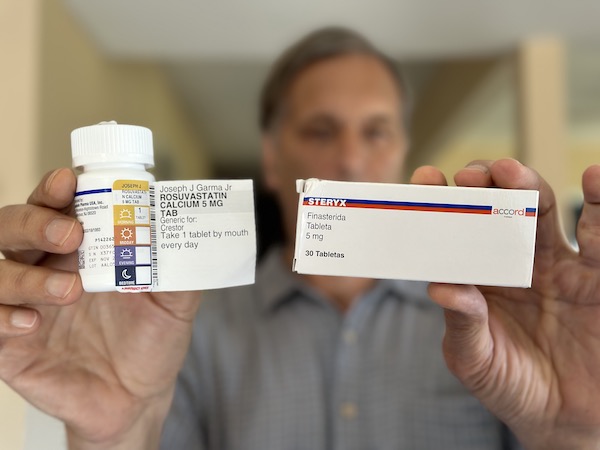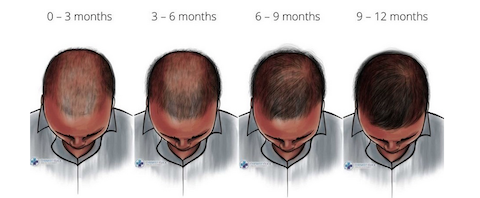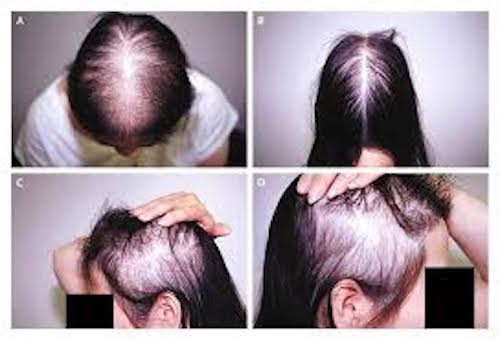My Two Drugs for Hair, Prostate and Heart Health

Prostate cancer is second most common cancer in men, and heart disease is the world’s #1 killer. Learn about the two drugs that can help, and encourage hair growth as well.
I take two drugs for hair, prostate and heart health: finasteride for hair and prostate; and rosuvastatin for heart health.
Oddly, finasteride might help grow or maintain your curly locks, and (for men) keep your prostate in check. And the statin rosuvastatin (also known as Propecia) can reduce the chances of a heart attack by reducing the amount of fatty deposits in your arteries and stop any more from building up. Statins also make existing deposits less likely to break off and cause a blood clot. A blood clot can cause a heart attack or stroke.
In this post, I’m going to share several studies with you that support my assertions. I will also include a review of these two drugs for hair, prostate and heart health made by the estimable Dr. Brad Stanfield. In the video below, he reluctantly divulged that he takes both finasteride and rosuvastatin, even though he’s just 30 years-old, has a full head of hair, and no prostate or cholesterol issues.
In my case, I could use some thicker hair, but like Dr. Stanfield, I have no prostate issues, and no longer have a cholesterol issue (more on that below).
So, why do we both take finasteride and rosuvastatin?
In a word: Insurance!
Watch Dr. Stanfield explain it all in the following video, and then read what I have to say about these two drugs, and my personal reasons for taking them.
Finasteride for Hair Loss and Prostate Health
Like Dr. Stanfield, I take about a one milligram dose of finasteride each day. You need a prescription for this, which I didn’t have, but I was in Mexico two months ago and there I bought some over-the-counter. What was available was a five milligram dose, so I put each pill in a pill cutter and quarter it, so actually I’m taking 1.25 mg per day of finasteride.
Low dose finasteride for hair
Multiple studies have investigated the effects of a one milligram dose of finasteride on hair growth and hair loss in both men and women.
Let’s look at two:
- The first is about male pattern baldness, and
- The second is about female pattern hair loss.
#1 Study: Finasteride for male pattern baldness [1]
A systematic review and meta-analysis published in 2020 examined 10 randomized controlled trials involving 4,155 men with androgenetic alopecia (male pattern baldness).
The findings:
- The meta-analysis confirmed that finasteride at a one milligram dose was significantly more effective than a placebo in promoting hair growth and reducing hair loss.
- The analysis showed that finasteride-treated participants experienced a higher hair count, increased hair density, and improved hair growth compared to those on placebo.
- The study concluded that finasteride is a safe and effective treatment for male pattern baldness.
#2 Study: Finasteride for female pattern hair loss [2]
A meta-analysis of nine studies involving a total of 490 patients examined the effectiveness of finasteride in treating female pattern hair loss (FPHL). ( A meta-analysis is a statistical analysis that combines data from multiple studies to provide a comprehensive overview of the treatment’s effectiveness.)
The findings:
- Finasteride exhibited an overall therapeutic effect in FPHL patients. It showed a positive impact on hair growth and improvement in hair loss symptoms.
- A high dose finasteride (≥2.5 mg) showed a better response rate than low dose (<2.5 mg), suggesting that a high dose of finasteride would be superior for FPHL treatment.
- Fnasteride was not effective in promoting hair density. This suggests that while finasteride may improve hair growth and reduce hair loss, it may not significantly increase hair density in FPHL patients.
- Overall, finasteride was found to be effective in treating FPHL by improving hair growth and reducing hair loss symptoms; however, it may not have a substantial impact on increasing hair density.
It is important to note that individual responses to finasteride may vary, and, again, it makes sense to ask your doctor about it.
These studies demonstrate that a one milligram dose of finasteride is effective in improving hair growth and reducing hair loss in both men and women with androgenetic alopecia or pattern hair loss. But unless you go to Mexico, you’re going to need your doctor to agree and write you a script.
If you’re a man, more might be at stake than your hair.
5 mg of finasteride for prostate health
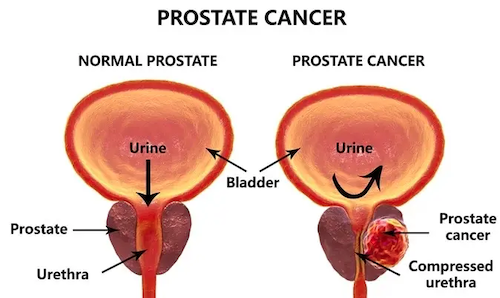
Illustration showing normal prostate gland and presence of tumor inside prostate gland which compresses urethra. Kateryna Kon / Shutterstock. From https://www.news-medical.net/news/20180410/Theresa-May-to-launch-c2a375m-drive-against-prostate-cancer.aspx
Prostate cancer is the second most common cancer in men and the fifth leading cause of death worldwide [3]. Finasteride can help by inhibiting the conversion of testosterone to dihydrotestosterone. In adults, dihydrotestosterone is associated with prostate enlargement and hair loss. It was hypothesized that by reducing dihydrotestosterone, finasteride could lower the risk of prostate cancer.
In 2003, a large study involving nearly 20,000 men was published. Half of them took five milligrams of finasteride (not the 1.5 milligram dose I’m taking, or Dr. Stanfield’s one milligram dose), while the other half received a placebo.
After a seven-year period, the finasteride group showed a 24% reduction in new prostate cancer rates compared to the placebo group. A follow-up study in 2013 revealed a 30% reduction in prostate cancer rates, but it also highlighted an issue. Although overall prostate cancer rates decreased in the finasteride group, there appeared to be an increase in high-grade or aggressive cancers. Furthermore, at that stage, no survival benefit was observed from taking finasteride.
A fascinating development occurred in 2019 when a study published in the New England Journal of Medicine showed that finasteride improved the detection of prostate cancers. The researchers extended the follow-up period to 18 years and found a 25% lower risk of death from prostate cancer with finasteride. Although this finding did not reach statistical significance, a clear trend was observed. The principal investigator, Dr. Ian Thompson, concluded that finasteride not only reduces the risk of prostate cancer but is also safe to use based on long-term follow-up in their study.
There are some potential downsides to taking finasteride:
- According to Dr. Stanfield, most randomized controlled trials have shown a reported increase of two to four percent in erectile dysfunction and libido issues.
- Additionally, a syndrome called post-finasteride syndrome has been officially recognized, where sexual, physical, and mental symptoms persist after discontinuing finasteride. Although this occurrence is extremely rare, you need to know about this risk before starting the medication.
So, as reported, I’ve been taking 1.5 milligrams of finasteride for the last two months, which is about the dosage (1 mg) for hair loss, without experiencing any side effects.
Adult men should regularly get a blood test called a prostate specific antigen (PSA) test that measures the level of PSA in the blood. I do this annually. Should my PSA rise, I will ask my doctor about increasing my dose of finasteride to 5 milligrams per day.
Enough said about finasteride — now let’s move onto rosuvastatin and cholesterol.
Rosuvastatin for High Cholesterol
The second drug I take is rosuvastatin at a dosage of five milligrams. About 18 months ago, I was prescribed this dose of rosuvastatin by my doctor as a preventative measure, but given that my blood test for total, HDL and LDL cholesterol were really good, I cut them in half.
But after reading some material authored by Dr. Peter Attia, I honed in on the most significant predictor of cardiovascular disease, apoB (apolipoprotein B), a protein involved in the metabolism of lipids.
As I describe in my two-part series about apoB, I took the test, got the results, fell to the floor gasping at the high level the test recorded, and then did something about it: 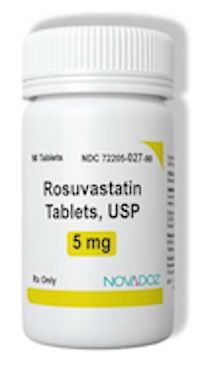
- I increased my rosuvastatin dose from 2.5 to 5 mg.
- I began taking supplements that my research indicated could help; namely: plant phenols, garlic extract, astaxanthin, citrus bergamot and fish oil.
Two months later, I retested, and my results went from a dismal 100 mg/dL to a very respectable 59 mg/dL. My intent is to drive even lower, like to 30 mg/dL. And perhaps the most important weapon in my arsenal is rosuvastatin.
Rosuvastatin is a medication that reduces the body’s production of cholesterol, particularly from the liver. Cholesterol is essential for various bodily functions, such as cell membranes, hormone production, and bile production. However, excessive cholesterol transported through the blood can lead to blockages in blood vessel walls, which is why we need to manage it.
The lipoproteins carrying cholesterol, specifically the apoB family, are of concern because their small size allows them to enter blood vessel walls, leading to blockages. It’s crucial to clarify that it’s not just small dense LDL cholesterol, but the entire APOB family, including different versions of LDL, that pose a risk. Lowering LDL cholesterol levels as much as possible has been recommended by the European Cardiology Society and the American Heart Association to prevent cardiovascular disease.
Numerous meta-analyses have shown that lowering LDL cholesterol progressively reduces total death rates. Although cholesterol is produced by our cells, reducing its levels through medications is considered safe, and very low LDL cholesterol levels are not associated with adverse events, but in fact further decrease cardiovascular disease risks.
Regarding risks, statin therapies may cause a slight increase in muscle pains for about one to two percent of people. However, they are not associated with cognitive impairment and may even provide protection against Alzheimer’s disease. Statins do not affect testosterone levels either.
For more about all this, read my posts:
Your Takeaway About Two drugs for Hair, Prostate and Heart Health
As we age, there’s a tendency for our hair to thin, for cholesterol to build up in our arteries and for a man’s prostate to enlarge, as possibly become cancerous.
Not a happy situation.
So, you might ask your doctor about:
- Taking 1 mg of finasteride to help keep that mane intact.
- Taking 5 mg of finasteride if you’re a male and older than 50, or 1 mg if younger with a good PSA level.
- Taking 5 mg of rosuvastatin if your cholesterol — as especially your apoB — levels are good to modest; a higher dose if not.
As I said before, for me and Dr. Stanfield, these two drugs for hair, prostate and heart health are mainly about insurance, and that’s why the dose is low. You may need a higher dose, or not need finasteride or rosuvastatin at all.
Last Updated on February 25, 2024 by Joe Garma

